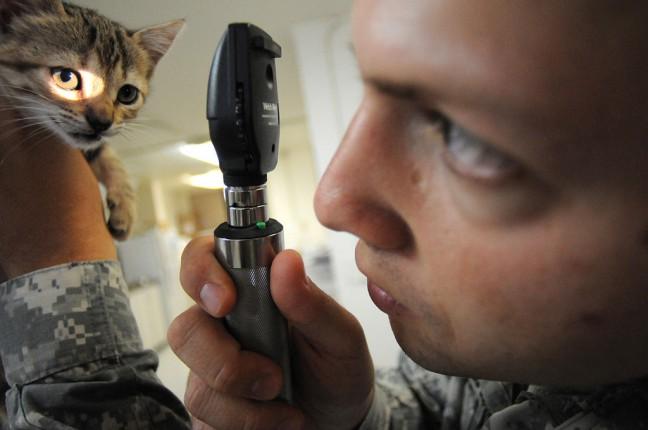The Wisconsin Alumni Research Foundation recently donated $15 million for expanding the current University of Wisconsin School of Veterinary Medicine.
The expansion comes after six years of planning, according to Mark Markel, the Dean of the School of Veterinary Medicine.
SVM was built 35 years ago. About four years ago, the class size of the veterinary school increased from 80 to 96. When the next year’s incoming class is admitted, SVM will be fully expanded in terms of student capacity, leading to severe space constraints, Markel said.
Previously, the UW Veterinary Care clinics saw about 12,000 patients a year. Now, they see 28,000, leading to severe overcrowding, Markel said.
Rachel McNally, UW veterinary medical student, said the facility doesn’t have the capacity to treat as many patients as they would like to.
“It’s great that we have this expansion so we can reach more of our clientele and provide them with better care,” McNally said.
Markel said the current space places constraints on teaching and learning spaces, and the new building will allow improvement on those items, particularly the hospital but also conference rooms.
Diana Lewis, UW veterinary medical student, said current students won’t get to experience the immediate benefits of the expansion, but is excited for future students who will benefit.
“I am really excited [because] we are super cramped for space here,” Lewis said.
About five years ago, SVM conducted a feasibility study to determine the need for a new building across the street, Markel said.
SVM worked with legislators, campus leadership, University system leadership and Gov. Tony Evers in regards to this project. July 3, SVM was granted $90 million and needed to raise another $38 million. Previously, the school raised between $25 and $26 million, and the addition of the WARF gift of $15 million puts the SVM over the $38 million they had to raise, Markel said.
The equipment the building is going to require is expected to be an additional $10 million, according to a UW News article.
According to Markel, the project received $90 million in state funding, SVM raised about $25 million and WARF donated $15 million, with the project budget about $128 million.
Construction is set to begin in Spring 2021 and is projected to be completed in two years. Renovations of the current building will be completed by 2024, according to UW News.
The Small Animal Clinic will be expanded on the first floor and will be double the size it currently is. The Morrie Waud Large Animal Hospital will be remodeled, including a new cover arena and large animal isolation facility. The second floor will be a laboratory, conference rooms, graduate student offices and faculty offices. Markel said the third floor will be an infectious disease research space.
The parking ramp on Observatory is under construction because the workers can’t build unless space is available for parking. Veterinary students, like Lewis, claim parking space constraints often provide various difficulties other than not having a place to park a car.
“It’s a stressor for people. Sometimes people bring in dogs or bigger animals that can’t walk. We do have carts that can get them into the building but there is a little bit of a strain there,” Lewis said.
SVM experienced severe equipment shortages over the years. The original building did not have MRI units and CT scanners in the clinics. The clinic was able to fit a CT scanner but it cannot be easily accessed. The MRI unit is in a trailer outside, Markel said.
“To get our animals scanned and on the MRI unit we have to anesthetize them in this building take them through about a hundred yards of corridors outside, so in the winter that’s through snow,” Markel said.
During the remodel, the MRI unit will be brought inside. The clinic pathology department will move into the new building, freeing up space in the current building. That space will likely accommodate the cancer center due to the large number of patients seen each year, Markel said.
Exam rooms have sign up sheets because there are not enough exam rooms available for the amount of appointments. There are only three computers in the neurology ward which makes looking up records or information about clients and patients in a timely manner difficult, said McNally and Lewis.
The surgery suite also has space constraints. When teaching about radiographs or diagnostics, faculty and students are huddled around one computer said Lewis and McNally.
It’s hard to learn under current space conditions, McNally said.
Clients and patients have also been affected by these space constraints.
“Sometimes you have to wait multiple months to get the initial patient appointment because they can only see so many patients in a day,” Lewis said. “I am amazed that we can fit as many appointments in a day that we can.”
There is a push to teach students and faculty how to make the clinic a comfortable space for pets and clients, they said, which can often be difficult with the high volume of patients and minimal space.
McNally said there should be an area in the new building to for pets to relax and quieter places for them to recover after procedures.
“It’s really hard to be a fear free space when there is so much noise and so much going on because we’re such a busy facility,” McNally said.
The WARF gift will buy new equipment, but students like McNally are excited about the little things such as chairs, computers and phones that will improve the quality of patient care.
The current building does not have many windows or courtyard spaces, McNally said, and this can affect the mental health of the clients and patients. The new building will have plenty of these additions.
“Little things can make our ability to provide care that much easier and that much higher quality that it can make such a huge difference,” McNally said.


